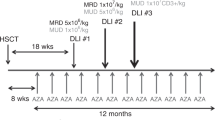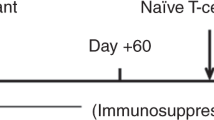Abstract
Use of IL-2 therapy after autologous transplantation is currently being explored to reduce relapse rate. Low doses of the cytokine induce significant immunomodulation avoiding the severe side-effects associated with high-dose IL-2 therapy. However, low-dose IL-2 is usually given by continuous infusion through central venous lines with the consequent risks of thrombosis and infections. Twenty-six consecutive patients who received autologous transplants received low-dose IL-2 after stable engraftment had been achieved. The first 13 patients (group A) were scheduled to receive 400000/IU/m2/day for 3 months by continuous intravenous infusion. Ten of these patients suffered infectious episodes, mainly bacteriemias that often necessitated delaying IL-2 therapy (median delivered dose: 32% of planned). The next 13 patients were then assigned to receive IL-2 (800000–1000000 IU/m2/day for 3 months) subcutaneously (group B). For group B patients, median dose intensity was 84% (P = 0.01 when compared with group A patients). Only one severe infectious episode was observed in these patients. Clinical toxicity in group B patients consisted mainly of s.c. nodules. Immunomodulation, measured as an increase in the absolute number of CD56+ cells and CD56+bright cells, was higher in patients who received the cytokine by the subcutaneous route (median peak increase of CD56+ cells: 160 and 220% for group A and B patients respectively; median peak increase of CD56+bright cells: 210% and 310% for group A and B respectively, P < 0.05 between groups a and b). no statistically significant increment of t lymphocytes was observed in any group. no hematologic toxicity was observed apart from eosinophilia, which was very marked in group b (P < 0.01). our results show that low-dose s.c. il-2 therapy is associated with low clinical and hematologic toxicity after autologous transplantation. the immunomodulation achieved is no less than that achieved with the i.v. approach.
This is a preview of subscription content, access via your institution
Access options
Subscribe to this journal
Receive 12 print issues and online access
$259.00 per year
only $21.58 per issue
Buy this article
- Purchase on Springer Link
- Instant access to full article PDF
Prices may be subject to local taxes which are calculated during checkout
Similar content being viewed by others
Author information
Authors and Affiliations
Rights and permissions
About this article
Cite this article
López-Jiménez, J., Pérez-Oteyza, J., Muñoz, A. et al. Subcutaneous versus intravenous low-dose IL-2 therapy after autologous transplantation: results of a prospective, non-randomized study. Bone Marrow Transplant 19, 429–434 (1997). https://doi.org/10.1038/sj.bmt.1700693
Received:
Accepted:
Issue Date:
DOI: https://doi.org/10.1038/sj.bmt.1700693
Keywords
This article is cited by
-
Immunomodulation of early engrafted natural killer cells with interleukin-2 and interferon-α in autologous stem cell transplantation
Bone Marrow Transplantation (2001)



